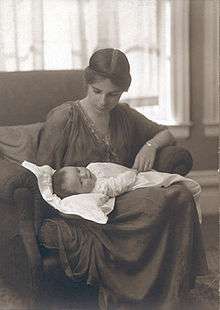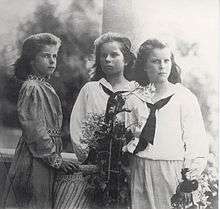Dorothy Burlingham

Dorothy Trimble Tiffany Burlingham (11 October 1891 – 19 November 1979) was an American child psychoanalyst and educator. A lifelong friend and partner of child psychoanalyst Anna Freud, Burlingham is known for her joint work with Freud on the analysis of children. During the 1960s and 70s, Burlingham directed the Research Group on the Study of Blind Children at the Hampstead Clinic in London. Her 1979 article on blind infants, "To Be Blind in a Sighted World," published in The Psychoanalytic Study of the Child, is considered to be a landmark of empathic scientific observation.[1]
Burlingham was the daughter of artist Louis Comfort Tiffany and the granddaughter of Charles Lewis Tiffany, founder of Tiffany & Co..
Young adult: New York and Europe

| Part of a series of articles on |
| Psychoanalysis |
|---|
 |
|
Important figures
|
|
Important works
|
|
Schools of thought |
|
Dorothy Trimble Tiffany was born in New York City. She married a New York City surgeon, Robert Burlingham, in 1914; however the couple separated in 1921 on account of Robert's bipolar disorder. Burlingham was also now raising four children, one of whom, a son, had developed a skin disorder, which was diagnosed to be psychosomatic. This was also the time that the new field of psychoanalysis was becoming better known both in Europe and the United States.
Holding out hope for a psychoanalytic cure for her son, Burlingham moved to Vienna with her four children in 1925. She soon began a lay analysis with Theodore Reik, before she moved to start an analysis with Sigmund Freud. She also met Anna Freud, who was already an analyst, and who took in all the Burlingham children as her patients. Soon, the Burlingham boy's skin disorder disappeared. This turn of events led Burlingham to become a lay analyst herself and, in preparation for it, to complete an analysis with Sigmund Freud, even though by now she had become personally close to Anna Freud. Her children's analysis, as well as her own analysis lasted for the rest of their days.
Work
Burlingham moved to London in 1938 along with the Freuds, who were fleeing Nazi anti-semitism. After Sigmund Freud's death the following year, Dorothy Burlingham settled at 2 Maresfield Gardens, not far from Anna Freud, and in 1940 she moved into the Freud home at 20 Maresfield Gardens, where she lived out her days. The two, who would remain partners for the next forty years, would found the Hampstead War Nurseries during World War II, and their joint work there would lead to the publication of Infants Without families (1943). They would also go on to found, along with Helen Ross, in 1951, the Hampstead Clinic, a center which "set out to provide therapy and assistance to families, to treat disturbed and handicapped children irrespective of their problems, social background or past history, and at the same time to offer aspiring analysts the most balanced and rich training possible." Both Burlingham and Freud would work at Hampstead until retirement.
Burlingham died in London in 1979. Her ashes rest in the Golders Green Crematorium, London, next to those of Anna Freud (who died in 1982) and others in the Freud family, including Sigmund Freud.
Notes
References
- Burlingham, Dorothy. (1952). Twins: A study of three pairs of identical twins. London: Imago Publishing.
- Burlingham, Michael John. (1989). The last Tiffany: A biography of Dorothy Tiffany Burlingham. New York: Atheneum.
- Enkell, Henrik (2001), "'I want to know too': Psychotherapy with a visually impaired boy", Psychoanalytic Study of the Child, 57: 286–313
- Freud, Anna, and Burlingham, Dorothy. (1943). Infants without families. London: G. Allen and Unwin.
- Burlingham, Dorothy (1979), "To be blind in a sighted world", Psychoanalytic Study of the Child, 35: 5–30
External links
- Works by or about Dorothy Burlingham at Internet Archive
- Burlingham-Tiffany, Dorothy (1891–1979)
- Tiffany Family Archives